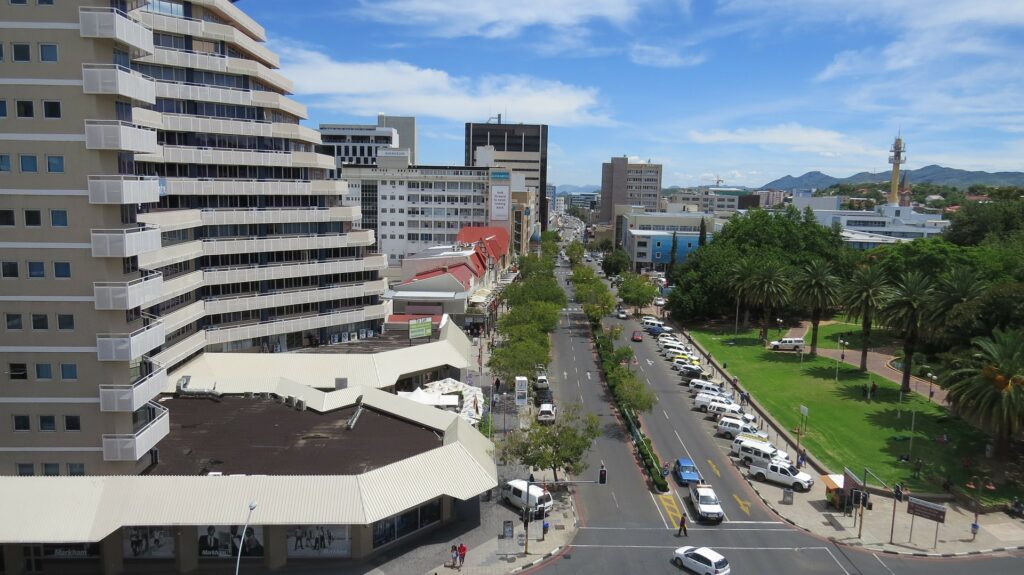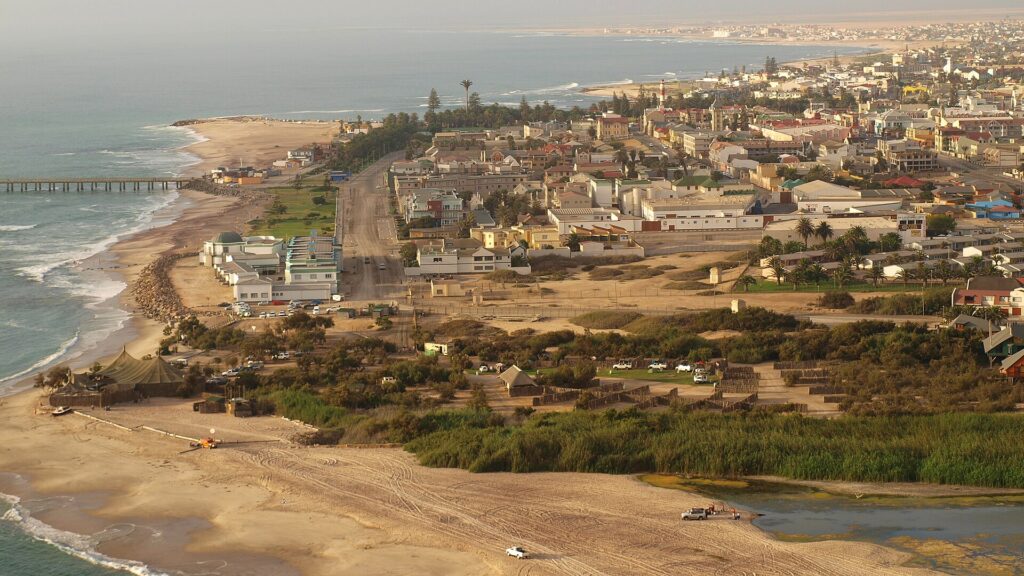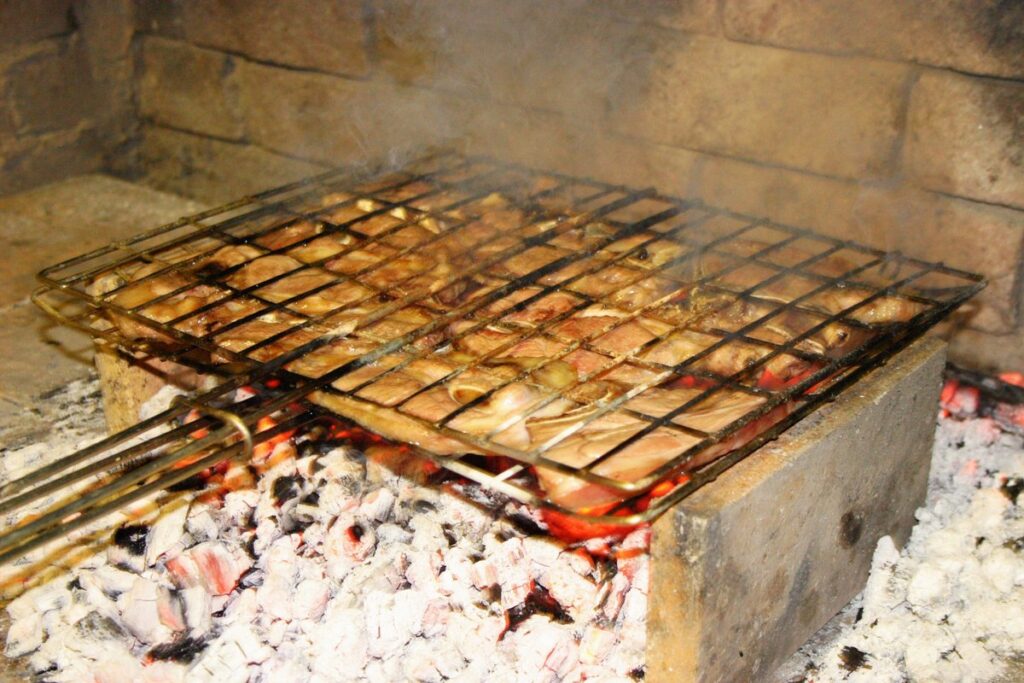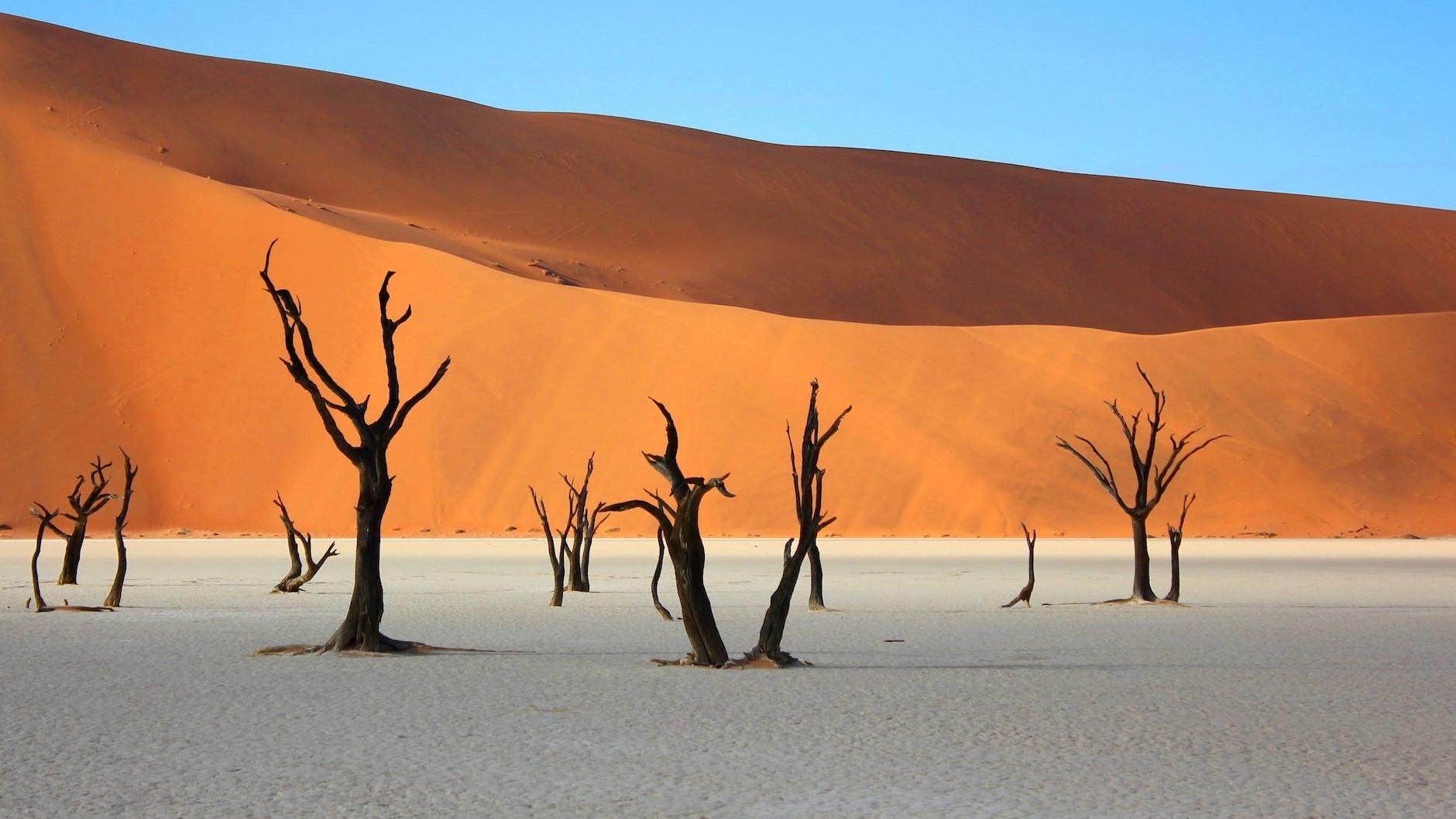Jump to Section
Namibia offers a breathtaking travel experience in 2024. Known for its stunning landscapes, Namibia promises adventure and wonder at every turn. The Skeleton Coast National Park shines during the African summer months with clear skies ideal for photos.
Sossusvlei’s beauty peaks between March-May and August-October, offering mild temperatures perfect for exploring dunes. Etosha also impresses from August to October when wildlife is easier to spot due to dry conditions. Join me as I unveil tips, destinations, and experiences that make Namibia an unforgettable journey!
City Guides Overview
Here’s a concise breakdown of the key highlights of various cities in Namibia:
| City/Location | Attractions | Cuisine | Cultural Highlights | Must-Do Activities |
|---|---|---|---|---|
| Windhoek | Central business district, vibrant architecture, museums, and local markets | Traditional stews (potjiekos), grilled game (kudu, crocodile), vetkoek (fried bread), pap (maize porridge) | German colonial history, vibrant local markets, traditional Namibian dances and music performances | City tours, visit local markets, dine at high-end restaurants, visit museums and cultural spots |
| Etosha National Park | Wildlife (elephants, lions, giraffes, rhinos), salt pan, Okaukuejo Camp, floodlit waterholes | Grilled meats, traditional African dishes, camping meals | Rich wildlife heritage, incredible birdwatching with over 340 species, nocturnal animal watching | Safari tours, early morning predator watching, stargazing at Okaukuejo, birdwatching, visit waterholes |
| Swakopmund | German colonial architecture, Swakopmund Museum, coastal beaches, Dune 7 | Fresh seafood (oysters, fish), grilled meats, traditional Namibian dishes (braai, potjiekos) | Unique blend of German colonial and Namibian culture, museum showcasing history and geology | Dolphin cruises, sandboarding, quad biking, stroll on the beach, visit the museum, explore local eateries |
| Sossusvlei | Sand dunes (Dune 45), Sesriem Canyon, desert landscapes, Rock Agama lizards | Traditional Namibian meats, local snacks, quick picnic lunches (salads and wraps) | Geological wonders, ancient desert landscapes, indigenous wildlife and plants | Dune climbing, desert treks, photographic tours, visit Sesriem Canyon |
| Himba Villages | Traditional Himba village life, sacred fire ceremonies, handmade jewelry, pottery, leather goods workshops | Local dishes (traditional meats, vegetables, and porridge) | Himba culture, ceremonial practices, traditional attire (ochre-dyed skin, intricate jewelry) | Visit Himba villages, participate in cultural ceremonies, learn traditional crafts, photography safaris |
Best Time to Travel to Namibia

The best time to travel to Namibia depends on what you want to experience. For clear skies and milder temperatures, visit Sossusvlei between March and May or from August through October. This period provides amazing photo opportunities with minimal rain.
If you’re keen on spotting wildlife, plan your trip during the dry season between August and October. During these months, animals gather around water sources making them easier to see. For those interested in visiting Skeleton Coast National Park, both African summer (November-February) and winter (May-August) months work well.
Combining this with a safari is ideal for an enriched adventure. In summary: Best visited from March-May or August-October.- Wildlife Viewing: Preferable during the dry season of August-October. Namibia offers different experiences depending on when you visit so plan according to what interests you most!
Planning Your Namibian Adventure

When planning your Namibian adventure, start with mapping out key destinations. Namibia’s vast landscapes mean long drives between attractions like Windhoek and Sesriem. Use platforms like Booking.com to find lodges along these routes by viewing hotels on a map and identifying suitable midpoints.
Accommodation in Namibia can be costly due to its sparse population. Lodging often involves luxury tents or high-end lodges that provide unique experiences such as listening to hippos at Ovita Wildlife Restcamp or dining atop cliffs at Vingerklip Lodge. If you’re budget-conscious, consider camping; it’s the more affordable choice but comes without many comforts of traditional lodging.
A reliable vehicle is essential for navigating this expansive country where public transport options are minimal. Most travelers prefer renting a car—ideally one with higher ground clearance—to handle gravel roads common across Namibia’s terrain even though we managed well enough in our modest Toyota Corolla despite some challenges. Be prepared for hours of driving through isolated yet stunning sceneries devoid of other vehicles—a true highlight if you cherish solitude amidst nature’s grandeur.
This sparsely populated nation offers incredible star-gazing opportunities thanks to some of the darkest skies globally making nighttime sky observations unforgettable. For additional accommodations not listed online, resorting to forum threads via simple Google searches proved helpful during my journey. Finding recommendations based on others’ firsthand experiences ensured comfortable stays outside major tourist trails, enhancing overall travel enjoyment in unanticipated ways.
Experiencing Etosha National Park Wildlife
Driving through Etosha National Park, I’m always on the lookout for wildlife. There are over 114 species of mammals here. You can spot lions lounging in the shade or elephants at waterholes.
I start early to catch predators like cheetahs hunting at dawn. Giraffes often meander past our vehicle while zebras graze nearby. Etosha’s vast salt pan attracts flocks of flamingos and pelicans during wet seasons—an incredible sight!



The contrast between dry land and vibrant life is striking. To improve my chances of seeing rhinos, I visit Okaukuejo Camp’s floodlit waterhole after dark. Patience pays off as these elusive creatures come to drink under a starlit sky.
Birdwatchers will love this park too—it houses more than 340 bird species! Look out for raptors such as martial eagles soaring overhead or colorful lilac-breasted rollers perched on branches below them. One tip: bring binoculars with you; they’re essential when spotting those distant animals across open savannas that stretch far away from main roads inside the reserve areas themselves!
Accommodation ranges widely, from luxurious lodges offering stunning views to budget-friendly campsites. Adventurers pitch tents beneath African skies filled with constellations glittering all night long. Visiting Etosha provides an unforgettable experience, bringing memories one would cherish forever.
Witness firsthand countless moments shared alongside nature; nothing beats being surrounded by true wilderness beauty.
Exploring the Coastal Town of Swakopmund
Exploring Swakopmund, I first noticed the German colonial architecture. The buildings have a unique charm and stand out against the vast desert backdrop. Walking down Sam Nujoma Avenue offers a blend of history with modern touches.
Swakopmund’s coastline is spectacular. I’ve spent mornings strolling along its beaches, where you can see fishermen casting lines into the Atlantic Ocean’s waves. Dolphin cruises are popular here; they’re fantastic for spotting marine life up close.





For adventure seekers, there’s sandboarding on nearby dunes at Dune 7 or quad biking through Namib Desert terrain which is just outside town limits. Both activities give an adrenaline rush while letting you appreciate Namibia’s natural beauty in fully immersive ways. The museum near Hohenzollernhaus covers local culture and geology comprehensively—great spot for learning before exploring further afield!
Local restaurants often serve fresh seafood straight from their waters, daily preparing delicious traditional dishes that keep diverse palates satisfied. Expert chefs skillfully showcase culinary masterpieces, representing the best flavors of the region and guaranteeing a uniformly delightful gastronomic experience.
Discovering the Dunes at Sossusvlei



The dunes at Sossusvlei are a sight to behold. I joined an Adventures Abroad tour and ventured into the immense Namib Desert, home to some of the world’s largest sand dunes. Coming from bitterly cold Canada, stepping into this hot, dry landscape was surreal.
We set out early in two Toyota Land Cruisers with our guides. Our journey started on Namibia’s heading south from Windhoek. After stopping briefly at Rehoboth for refreshments and learning about local history via interpretive panels, we continued on.
Throughout our drive through rocky terrain dotted with life like the nimble Rock Agama lizard searching for beetles among granitic boulders, each stop unveiled new curiosities of this unique land rich in geological wonderment. Around midday, under the shade of camelthorn acacia trees, we had a quick picnic featuring salads and wraps. After resuming travel toward Sesriem Canyon, we were captivated by intricate tales and striking visuals, leading to volunteer climbing adventures and a refreshing end to the day.
Cultural Insights into Himba Communities



Visiting Himba villages offers a glimpse into their unique way of life. One can observe intricate hairstyles, ochre-dyed skin, and jewelry made from shells and metals. These guided visits allow tourists to interact with Himba families.
Participating in cultural ceremonies is another enriching experience. The sacred fire ceremony or holy smoke ritual holds deep spiritual meanings for the Himba people. Learning traditional crafts is also possible during these village tours.
Skilled artisans teach you how they make jewelry, pottery, and leather goods through hands-on workshops. Himba cultural performances are filled with music, dance, and storytelling that captivate visitors while showcasing their rich heritage. Photography enthusiasts will find great opportunities here too.
Guided photographic safaris let you capture authentic moments without disrupting daily life or disrespecting customs. Some tour operators offer homestays where travellers live among the Himba community participating in day-to-day activities like milking cows or fetching water which helps them understand nuances better than just brief visits could offer. Choosing responsible tour operators ensures meaningful interactions respecting tribal cultures maintaining authenticity ensuring sustainability supporting local economies directly benefiting native communities helping preserve this fascinating culture intact amidst modernity encroaching steadily upon ancient traditions globally today more so ever before!
Respecting norms seeking permission showing genuine interest asking respectful questions engaging meaningfully buying handmade crafts donating contributes towards sustainable development fostering mutual understanding deeper appreciation rich but delicate tapestry lasting memories lifetime!
Navigating Local Cuisine and Dining Options
When navigating local cuisine in Namibia, be prepared for unique flavors. You’ll find a mix of African and German influences. Try the kapana, which is grilled meat sold by street vendors.
Pair it with some vetkoek (fried dough bread) for an authentic snack. In coastal regions like Swakopmund, seafood dominates menus due to the Atlantic Ocean’s proximity. Fresh oysters are a must-try there if you love shellfish.



Namibia’s capital Windhoek offers diverse dining options from high-end restaurants to casual eateries serving traditional dishes like potjiekos—meat stew cooked over an open fire—and pap—a maize-based porridge often served as a side dish. While exploring rural areas or smaller towns, remember many places only accept cash and may not have ATMs readily available even gas stations lacking them too so always carry enough Namibian dollars with you. As for beverages try locally brewed beers such as Windhoek Lager or Tafel Lager; these brews reflect the country’s strong brewing culture inherited from German settlers.
Also keep note that fried mopane worms though unusual incredibly popular among locals rich iron source lightly salted sometimes spicy perfect beer companion! For dessert do taste melktert similar custard pie but lighter crust deliciously sweet finish traditional meal suffice! Dining out will reveal much about Namibia’s history, traditions, and mouthwatering fare.
Experience an unforgettable journey through its culinary landscape, savor every bite, and feel a connection to the vibrant land and hospitable people. Exploring Namibia in 2024 offers a unique adventure. From the vast dunes of Sossusvlei to Etosha’s wildlife, there’s something for every traveler. The vibrant culture and stunning landscapes create unforgettable memories.
Whether you seek thrilling safaris or peaceful desert treks, Namibia provides it all with style. Don’t miss exploring local markets and tasting traditional foods! This guide ensures you’re well-prepared for an amazing trip filled with wonder at each turn.
So pack your bags; Namibia awaits your discovery next year!
Discover a wealth of valuable travel articles by visiting our blog page, brimming with an abundance of tips, guides and inspiration for your upcoming adventures. Whether you’re in search of insider knowledge on unexplored destinations or seeking pocket-friendly advice to facilitate budget travel – we cater to every kind! Our wanderlust-inducing storytellers ensure that each journey is enthralling; curated collections take the reader on a voyage through hidden gems and invite them into their next unforgettable destination where they will be carried away by exploration.





Leave a Reply